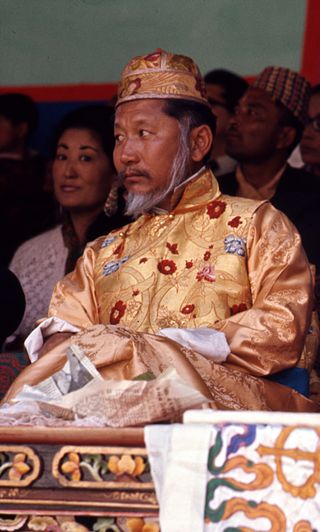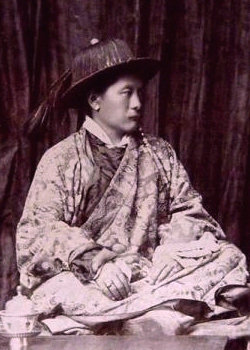
Palden Thondup Namgyal was the 12th and last Chogyal (king) of the Kingdom of Sikkim.

Tashi Namgyal was the ruling Chogyal (King) of Sikkim from 1914 to 1963. He was the son of Thutob Namgyal. He was the first independent king of Sikkim.

Hope Cooke was the "Gyalmo" of the 12th Chogyal (King) of Sikkim, Palden Thondup Namgyal. Their wedding took place in March 1963. She was termed Her Highness The Crown Princess of Sikkim and became the Gyalmo of Sikkim at Palden Thondup Namgyal's coronation in 1965.

The Chogyal were the monarchs of the former Kingdom of Sikkim, which belonged to the Namgyal dynasty. The Chogyal was the absolute monarch of Sikkim from 1642 to 1973, and the constitutional monarch from 1973 to 1975, when the monarchy was abolished and the Sikkimese people voted in a referendum to make Sikkim the 22nd state of India.

The history of Sikkim begins with the indigenous Lepcha's contact with early Tibetan settlers. Historically, Sikkim was a sovereign Monarchical State in the eastern Himalayas. Later a protectorate of India followed by a merger with India and official recognition as a state of India. Lepchas were the main inhabitants as well as the Ruler of the land up to 1641. Lepchas are generally considered to be the first people, indigenous to Sikkim also includes Darjeeling.

Yuksom is a historical town in Geyzing subdivision of West Sikkim district in the Northeast Indian state of Sikkim. It was the first capital of Kingdom of Sikkim established in 1642 AD by Phuntsog Namgyal who was the first Chogyal of Sikkim. The coronation site of the first monarch of Sikkim is known as the "Throne of Norbugang". Yuksom is where there is the Norbugang Chorten near the Norbugang throne, the place Namgyal was crowned and several monasteries and a lake. The dynastic rule of the Chogyals lasted for 333 years.

Rabdentse was the second capital of the former Kingdom of Sikkim from 1670 to 1814. The capital city was destroyed by the invading Gurkha army and only the ruins of the palace and the chortens are seen here now. However, the ruins of this city are seen close to Pelling and in West Sikkim district in the Northeastern Indian state of present-day Sikkim; Pemayangtse Monastery is one of the oldest monasteries in Sikkim which is close to the ruins. From the vantage point of this former capital, superb views of the Khanchendzonga ranges can be witnessed. This monument has been declared as of national importance by the Archaeological Survey of India. It was first established in 1670 by the 2nd Chogyal Tensung Namgyal son of the 1st Chogyal Phuntsog Namgyal by shifting from the first capital of Yuksom that was consecrated in 1642.

Phuntsog Namgyal (1604–1670) was the first chogyal (monarch) of Sikkim, now an Indian state. He consecrated in 1642 at the age of 38. Phuntsog was a fifth generation descendant of Khye Bumsa, a 13th-century prince from the Mi-nyak House in Kham in Eastern Tibet. According to legend, Guru Rinpoche, a 9th-century Buddhist saint had foretold the event that a Phuntsog from the east would be the next chogyal of Sikkim. In 1642, three lamas, from the north, west, and south went in search for the chosen person. Near present-day Gangtok, they found a man churning milk. He offered them some refreshments and gave them shelter. So impressed were they by his deeds that they realised that he was a chosen one and immediately crowned him king. The crowning took place Norbughang near Yuksom on a stone slab in a pine covered hill, and he was anointed by sprinkling water from a sacred urn.
Tensung Namgyal (1644–1700) was the second chogyal (monarch) of Sikkim. He succeeded his father Phuntsog Namgyal in 1670 and moved the capital from Yuksom to Rabdentse near Geyzing. He had three wives from Bhutan, Tibet and a Limbu princess, Thungwamukma. After establishing Rabdentse as his new capital he built a palace and asked his Limbu Queen to name it. She named it "Song Khim" which in Limbu language means "New Palace". This later went on to become "Sukhim" and "Sikkim". He was succeeded by his son Chakdor Namgyal, borne by his second wife in 1700. He had one last son with his third wife. Though he is not well known his grandson becomes a king of a small kingdom inside his father's rule.

Tashi Namgyal Academy (TNA) is a public school in the Himalayan state of Sikkim in India. It was founded in 1926 by the late Sir Tashi Namgyal, KCSI, KCIE, the 11th consecrated Ruler of Sikkim. It is an autonomous English-medium, co-educational and residential-cum-day school.
Chogyal Wangchuk Tenzing Namgyal is the second son of Palden Thondup Namgyal, the last sovereign king of Sikkim. Educated at Harrow, he is also the present heir of the Namgyal dynasty and pretender to the throne of Sikkim.

Thutob Namgyal was the ruling chogyal (monarch) of Sikkim between 1874 and 1914. Thutob ascended to the throne succeeding his half-brother Sidkeong Namgyal who died issueless. Differences between the Nepalese settlers and the indigenous population during his reign led to the direct intervention of the British, who were the de facto rulers of the Himalayan nation. The British ruled in favour of the Nepalese much to the discontent of the chogyal, who then retreated to the Chumbi Valley and allied himself with the Tibetans.
Tsugphud Namgyal (1785–1863) was king of Sikkim from 1793 to 1863. He gained independence from Nepal in 1815 and ruled under a British protectorate from 1861.

Sidkeong Tulku Namgyal was the ruling Maharaja and Chogyal of Sikkim for a brief period in 1914, from 10 February to 5 December.
Sidkeong Namgyal (1819–1874) was king of Sikkim from 1863 to 1874. He was son of Tsugphud Namgyal and was succeeded by his half-brother Thutob Namgyal.
Chakdor Namgyal was the third Chogyal (king) of Sikkim. He succeeded Tensung Namgyal in 1700 and was succeeded himself by Gyurmed Namgyal in 1717.
Gyurmed Namgyal was the fourth Chogyal (king) of Sikkim. He succeeded Chakdor Namgyal in 1717 and was succeeded himself by Phuntsog Namgyal II in 1733.
Tenzing Namgyal was the sixth Chogyal (king) of Sikkim. He succeeded Phuntsog Namgyal II in 1780 and was succeeded himself by Tsugphud Namgyal in 1793.
Sikkim National People's Party (SNPP) was a regional political party (State Party (Unrecognized)) in the Indian state of Sikkim. Election symbol was Pen Nib. SNPP didn't have any relationship with Sikkim National Party (SNP) in same state or National People's Party (NPP) in the state of Meghalaya.

The State Council of Sikkim was the legislative body of the erstwhile Kingdom of Sikkim, which was located in the Himalayas, between India and China.










